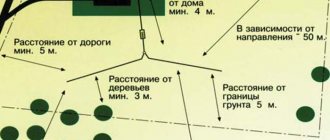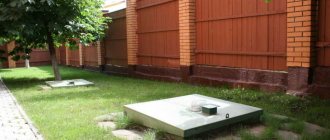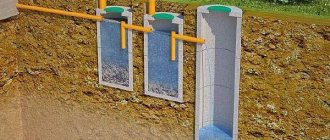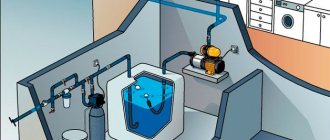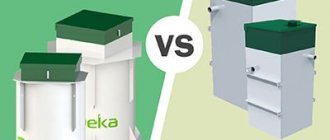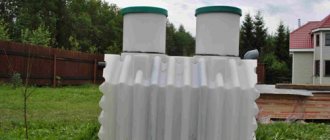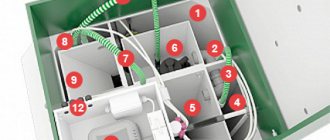Share
An introductory article for those readers who are just deciding on the choice of a device for cleaning sewage in a suburban area. We will tell you what Topas is. General information based on which you can decide whether you need this particular solution, or should you look towards other manufacturers.
Topas is the name of a device for processing household wastewater, which is used in places where it is difficult or impossible to connect to a central sewerage system. For example, for cleaning drains in a country house.
This is what it looks like in a suburban area
Topas belongs to the class of treatment facilities for deep biological treatment and requires electricity for its operation. Although almost everyone calls it a septic tank, this is not correct. The operating principles of a septic tank and a deep biological treatment station are completely different.
People now call septic tanks all devices that perform the function of purifying sewage. Topas, or mistakenly Topaz, is the name given to any biological treatment plant with a green square lid rising above the ground. Over time, the name became a household name, by analogy with the automobile brand “jeep”.
The treatment station is connected to the outlet of the sewer main of the house, and after processing, clean process water comes out.
Layout of the site
Story
TOPAS was designed, received a patent for the invention, and set up production in the Czech Republic by engineer Jan Topol. That's exactly what it is called in English, all over the world. It is called that for a reason. TOP - from the surname Topol, A - activation, C - system. However, in Russia the situation is different - the rights to the Topas trademark belong to the Topol-Eco group of companies.
In the 2000s, Jan Topol entered the Russian market with his products, founding the Topol-Eco company together with several founders, which began production of Topas septic tanks in Russia. A few years later, the campaign was overtaken by a crisis. Jan Topol, together with several founders, left Topol-Eko. Almost everyone who came out founded their own production of treatment facilities of a similar design, but with different names. And Topol went to the Czech Republic to drink beer and work in the European market. True, some of the newly formed companies still continue to cooperate with him.
Why is an integrated approach beneficial?
Topas are treatment facilities whose price is determined not only by monetary investments, but also by the time resource spent. The installation team will take on tasks that may seem insignificant at first glance, but require attention and literacy. As a guide, we take the calculation previously performed for the Topas septic tank and the nature of the selected equipment.
How high-quality the sewage system of a Topas country house will be depends on the following factors:
- Correct choice of pipes. A cheaper PVC pipe can be used indoors, but special pipe material is intended for laying in the ground. It can be distinguished by its orange color. Treatment facilities for a private house Topas will function correctly if, when laying pipes, a slope of 2-4 degrees is maintained for each linear meter. Ignoring this condition is fraught with blockage of the system with heavy fractions of sewage.
- The Topas aeration installation must be at least 5 m away from the foundation of a residential building. If necessary, the pipes are insulated.
- Optimal configuration of aerobic equipment. To a certain extent, the cost of the compressor determines how much an autonomous Topas sewage system costs - you can only buy it assembled.
- The height of the septic tank depends on the depth of the sewer pipeline. In certain cases, only the Topas Long installation can be used. We are talking about situations when a treatment plant is integrated into an existing sewer system and it is not possible or impractical to change its design. Topas long is also indicated for use in regions with low-temperature climates and in areas with high groundwater levels.
- At the request of the client, we can equip the basic package with additional equipment. For example, the use of a voltage stabilizer will allow you to protect an expensive compressor or pumps from voltage surges in the electrical network. In general, the autonomous sewers of the Topas house are designed in such a way that there is nothing to break in them. The absence of metal parts inside the septic tank eliminates the problem of corrosion. Thanks to special bacterial microflora, fats are removed from the system, which eliminates the possibility of system clogging. Numerous responses from our clients indicate that the Topas local treatment plant is definitely the right choice - the price of comfort is reasonable.
What does it look like
The septic tank is a welded polypropylene container in the shape of a parallelepiped with a green neck, ending with a lid. The green color is due solely to the aesthetic component. The cover is located at a level of 20 cm above the ground level and its color is in harmony with the vegetation.
There are several dozen models. They differ in size and productivity: the smallest ones are capable of processing wastewater from 2-4 people, large treatment plants - up to 150 residents. At the same time, 150 is not the limit; several installations can be combined with each other, obtaining a treatment facility of even greater power. Each model has several modifications: according to the method of discharging purified water, the maximum depth of the supply sewer pipe.
Topas-5
Topas-8
Topas-15
Topas-20
Maintenance of septic tanks Topas
Once every 1-2 weeks, it is necessary to open the station cover and visually monitor its operation, and according to the instructions in the data sheet, the manufacturer recommends:
- Once every 3-6 months (depending on the intensity of use): → clean the injectors of cycles 1 and 2; → clean the airlift pumps and the coarse fraction filter in the receiving chamber; → remove sludge sediment from the stabilizing chamber using a standard airlift pump. For Topas-15 and higher models, a fecal pump will be required, which is not included in the station kit and must be purchased separately by the customer; → remove non-recyclable waste using a stainless sieve; → flush the Topas system itself.
- Clean the compressor air filter once a year;
- Change the compressor membranes every 2 years;
- Once every 5 years, clean the bottom of the receiving chamber from mineralized sediment;
- Once every 10 years, replace the aeration elements on aerators.
Brief instructions for removing sludge using a built-in airlift pump
De-energize the station in the compressor compartment. After 20 minutes, unscrew the clamp and remove the plug on the hose of the sludge stabilizer airlift pump.
Force the station into the direct pumping phase and turn it on by raising the float switch in the receiving chamber.
Pump out about 50% of the volume of sludge stabilizer, then immediately replenish it with clean water to the original level.
What is inside
Inside the housing there are several compartments for various purposes, through which wastewater is purified. They can be disposed of without fear of sanctions from environmental authorities. Treated wastewater does not harm the environment and does not have an unpleasant odor.
Location of compartments
According to the cleaning principle, Topas is a relative of large urban wastewater treatment plants, with the difference that all cleaning processes take place inside one compact housing. At the same time, it is not afraid of frost, does not require the addition of biological additives or calling a vacuum cleaner.
Read more about the device in the article: How Topas works. Schemes and principles of operation.
The design involves the use of sewerage in summer and winter. In this case, no special insulation measures are required. Although some users still prefer to play it safe by covering the lid with sheets of thermal insulation material.
For almost twenty years of existence on the Russian market, this septic tank has deservedly become one of the most popular solutions for wastewater treatment. This is explained by the high quality of purified water at the outlet, compactness, ease of installation, and the ability to perform maintenance yourself. But despite all its advantages, it is not suitable for everyone and is not without its disadvantages.
Connection to the central sewerage system
This is apparently the most civilized method - a system of sewer pipes is removed from the country house and extended to the nearest central sewer collector. It is clear that this method is completely unsuitable if the dacha is located far beyond the city limits. But even if you are lucky and the central sewerage system is within reach, just receiving official permission to tap into it will become such a bright and unforgettable event in your life that even decades later you will hardly be able to remember it without irritation.
But obtaining a permit will not save you from the need to spend a lot of money on carrying out all the necessary work on laying pipes and connecting - after all, this can only be done by companies officially authorized to carry out such work. You can be sure that they will try to use their special status and take as much money for these works as possible.
The main thing is that the scale of all these troubles and expenses is completely incomparable with the modest scale of a small house outside the city. This method is only appropriate for large hotels or recreation centers, but not for summer residents.
Advantages
- High quality of cleaning – more than 95%;
- The minimum occupied area on the site is from 1 sq.m.;
- Easy installation - completed in 1 day, does not require a concrete base* or anchoring;
- During operation, does not require pumping with a sewer truck;
- Suitable for permanent use, seasonal living;
- Easy maintenance that you can do yourself;
- No need to add activators or various dietary supplements;
- The plastic case is not subject to corrosion, the service life declared by the manufacturer is more than 50 years;
- Excellently withstands all the hardships of the Russian climate;
- No unpleasant odors.
* - the concrete base is poured for models designed for more than 20 residents.
Do you care about the environment in your area?
Buy a Topas septic tank for your country house from the Ecology Center company!
Homemade sewerage devices have low efficiency. Most often they operate on the principle of a sump, providing less than 50% purification. The remaining contaminants enter the soil, spreading an unpleasant odor around. For those who take a responsible approach to issues of environmental protection and ensuring their own comfort, TOPAS offers to buy inexpensive septic tanks. This is the optimal solution for small dachas, large cottages, and commercial properties in Moscow or the Moscow region. In addition to selecting and selling a cleaning system, we are also ready to perform turnkey installation of an autonomous sewer system and subsequent qualified maintenance.
Flaws
- Sewage will not be properly treated in the complete absence of fecal waste;
- Volatility dependence - without the availability of electricity, Topas turns into a storage tank;
- You cannot buy “with a reserve” for the future; you should choose based on the planned number of residents;
- Not everything can be processed by Topas. It is necessary to control the nature of the wastewater. Read what you can throw into Topas and what you can’t;
- Don't forget about maintenance for too long.
Analysis of shortcomings If the first point is critical for you, then start looking for another solution.
Energy dependence: this disadvantage is very conditional. During short-term power outages in the house, in addition to the treatment plant, other engineering systems (pumps, boilers) do not work. Water consumption by residents at this moment is minimal, so such utility difficulties are not at all critical. It’s another matter if there are regular long-term interruptions (for several days) in the power supply. Then you still have to look for another non-volatile solution.
You really can’t buy a septic tank with a reserve. If you install Topas-20 (for 20 residents), and five people use it, and only on weekends, then you will not get high-quality work from the system. Here, too, there is something to think about... Why install an installation of obviously higher power? You can always complement a small installation with another one by combining them into a common system. Or install 2 small models at once, mothballing one of them and launching it as needed.
Regarding what can be drained into the sewer, the following can be said. For frequent owners, this is a matter of discipline and can be solved quite simply. For wastewater treatment plants with a large number of residents, where it is impossible to keep track of everyone, there are engineering solutions that allow minimizing harm to the installation from the discharge of unwanted wastewater.
A sewage treatment plant, like any equipment, requires some attention. Don't forget about this. Before making a purchasing decision, you can evaluate the difficulty of performing Topas maintenance yourself. Or you can entrust this work to our service department.
Station operation in winter and conservation
Insulation is installed in the lid of the septic tanks. It maintains a stable temperature in the tank in mild frosts. If a residential building is located in a zone with winter air temperatures down to -20˚, insulation of the outer part of the tank is not carried out. When the air temperature drops below - 15˚, the lid of the container is not opened.
To ensure full operation of the system in frosts below 20 degrees, during installation the housing is insulated with mineral wool and expanded polystyrene.
Before buying a septic tank from the first seller you come across, we recommend getting advice from a specialist who will perform calculations and tell you which Topas model is suitable in each specific case.
The conservation of the Topas station for the winter or long period is carried out as follows:
- Pump out the contents of all chambers one by one (no more than 40% of the volume), filling with clean water to the previous level. Do this in several approaches, starting from the sludge stabilizer settling chamber→aeration tank chamber→receiving chamber, until the water is completely clarified;
- Rinse the station with water pressure from a hose;
- Clean airlifts, nozzles and pumps;
- De-energize the skeptic;
- Remove the compressor and pump (in models with forced drainage);
- Additionally, insulate the station cover with a material that does not absorb moisture (For example, a sheet of foamed polypropylene with a thickness of more than 50 mm).
Price
Now about the main thing. At the time of publication of the material, the dealer cost of Topas-S - 4 minimum productivity, designed for 2-4 residents, is 71,010 rubles. Add here the cost of delivery, turnkey installation, and the price of associated costs (and believe me, there will be some). The total cost of installation on a summer cottage will cost you at least 95,000-100,000 rubles.
We told you what Topas is and now the choice is yours. If you are ready to get all its advantages, the disadvantages are not scary, and the price is reasonable, then we will continue to delve into the design features. Or you can order an engineer to come to your site. On the spot, he will tell you everything, tell you what is better, cheaper and calculate all the options. The most important thing is that it's free.
Next: Design and principle of operation of Topas
If the article was useful to you, share the link with your friends
Warranty terms and conditions
Attention! Make sure that the seller has completely filled out the warranty card indicating all serial numbers of the product, as well as the type of station, size, date of sale, stamp of the trading organization and signature of the responsible person or seller.
Provided that the Topas station was purchased from a legal seller and operated in accordance with the technical passport, the warranty period is 36 months from the date of its commissioning (if there is no mark on commissioning in the technical passport, the warranty period starts from the moment of installation, if there is no this mark, then from the date of sale, but not more than 48 months from the date of sale by the manufacturer). The warranty covers all defects caused by the manufacturer.
Note
: The warranty period of the control unit is 1 year if all factory seals are preserved. The warranty for pumps, compressors and other electrical equipment is regulated by the manufacturers of these products and is stated in the passport.
The warranty does not apply if:
- defects arising due to the fault of the consumer due to violations of the operating rules or installation of the installation;
- making changes to the design without agreement with the manufacturer.
Why is activated sludge needed?
Activated sludge is a mixture containing microorganisms that carry out purification. Under the influence of bacteria, further decomposition of feces occurs. For them to function, there must be oxygen in the environment. In this station, the elimination of organic matter is carried out by aerobic bacteria, provided with oxygen using equipment.
Biological cleaning with sludge in combination with fine-bubble aeration allows you to get a good effect. As a result of the work of bacteria, the water after purification becomes clean and transparent. Bacteria that destroy organic components are completely harmless and multiply quickly.
